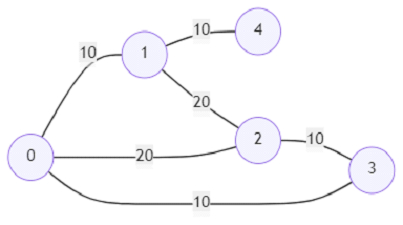在Python中找出无向图中是否存在顶点的较低代价路径的程序
假设我们有一个加权的无向图。我们必须实现一个名为query的函数,它将两个顶点和一个成本“限制”作为输入并检查是否存在比输入成本更低的路径。如果存在路径,则返回true,否则返回false。
因此,如果输入如下所示

并且查询为(0,2,10),(3,1,30),(4,3,30)。
那么结果将是
False
True
True
第一个查询的结果为False,因为没有从顶点0到顶点2成本为10的路径。
第二个查询的结果为True,因为顶点3到顶点1的成本为10的路径存在,小于30。
第三个查询的结果为True,因为顶点4到顶点3的成本为30的路径存在,等于30。
为了解决这个问题,我们将按照以下步骤进行 –
- weights := 包含图中不同权重的列表
-
connections := 包含权重的连接的列表
-
定义函数query()。这将获取p,q,limit
- index := 在此处可以将limit插入到左侧以维护排序顺序
-
如果index和0相同,则
- 返回False
- 如果connections [index-1,p]与connections [index-1,q]相同,则返回True
示例
让我们看一下以下实现,以获得更好的理解:
import bisect
class Solution(object):
def __init__(self, n, edgeList):
def find(node):
if parent[node]!=node:
parent[node] = find(parent[node])
return parent[node]
def union(x,y):
parent[find(y)] = find(x)
return
parent = {i:i for i in range(n)}
edgeList.sort(key = lambda x:x[2])
self.connections = []
self.weights = []
for index,(i,j,weight) in enumerate(edgeList):
union(i,j)
if index!=len(edgeList)-1 and weight == edgeList[index+1][2]:
continue
self.weights.append(weight)
self.connections.append([find(i) for i in parent])
def query(self, p, q, limit):
index = bisect.bisect_left(self.weights,limit)
if index==0:
return False
return self.connections[index-1][p] == self.connections[index-1][q]
ob = Solution(5, [[0, 1, 10], [0, 2, 20], [1, 4, 10], [0, 3, 10], [1, 2, 20], [2, 3, 10]])
print(ob.query(0, 2, 10))
print(ob.query(3, 1, 30))
print(ob.query(4, 3, 30))
输入
ob = Solution(5, [[0, 1, 10], [0, 2, 20], [1, 4, 10], [0, 3, 10], [1, 2, 20], [2, 3, 10]])
print(ob.query(0, 2, 10))
print(ob.query(3, 1, 30))
print(ob.query(4, 3, 30))
输出
False
True
True
 极客教程
极客教程